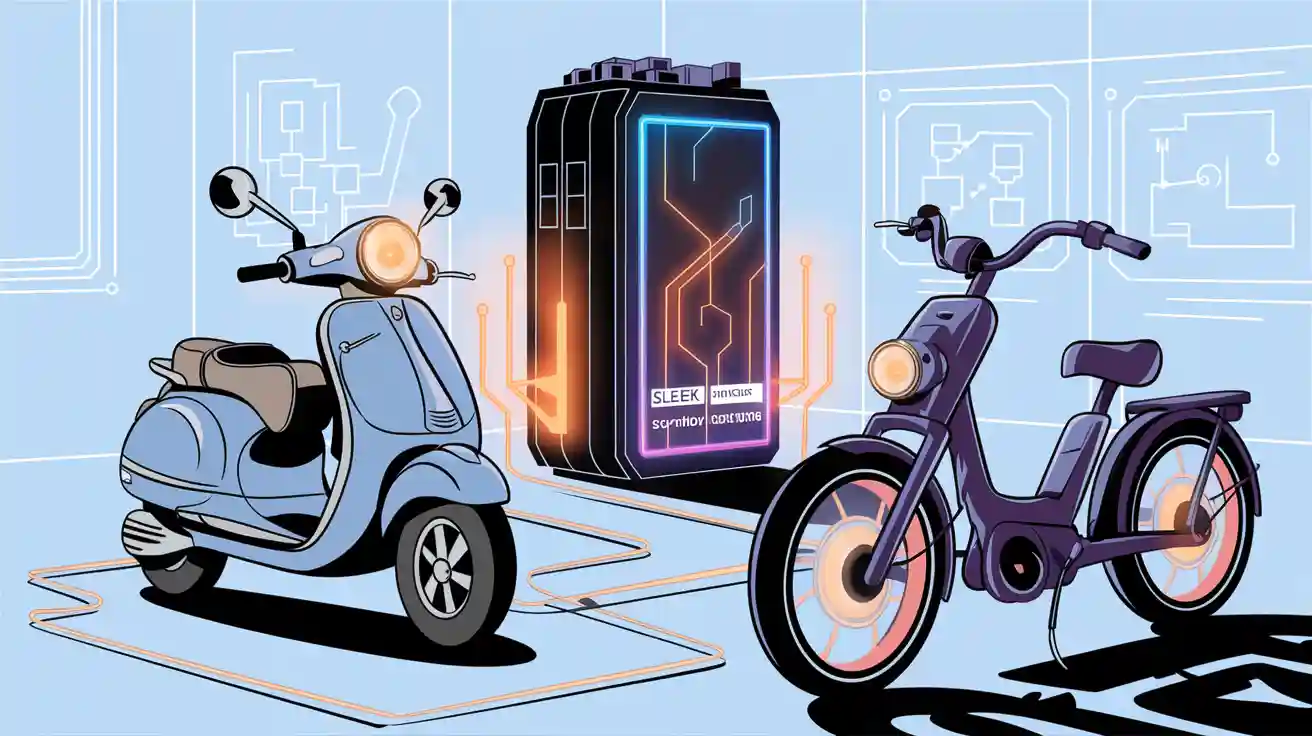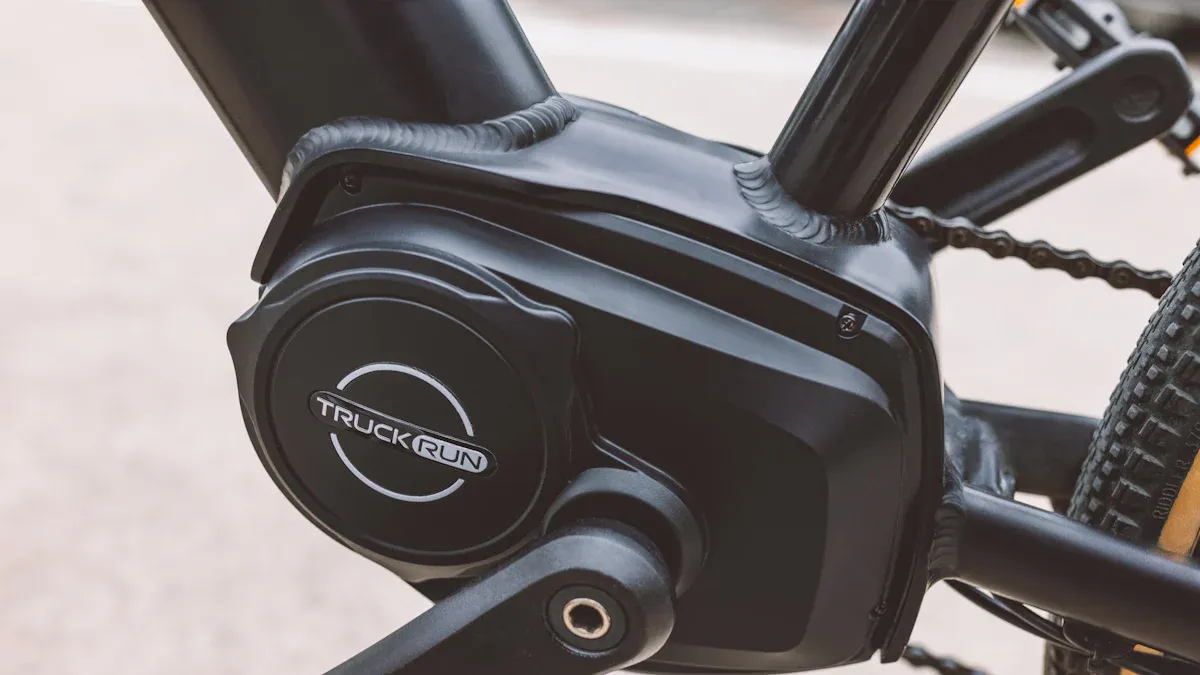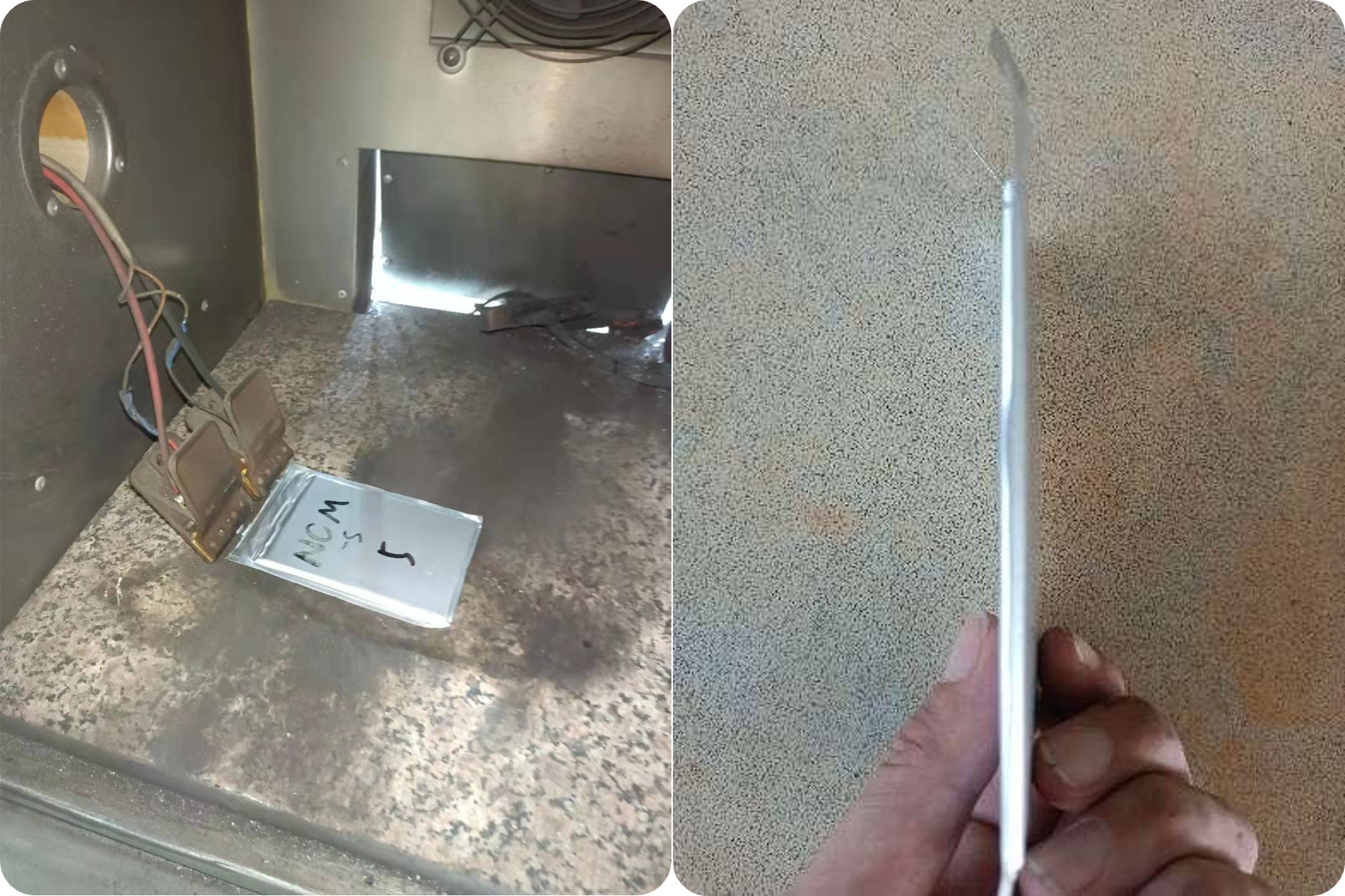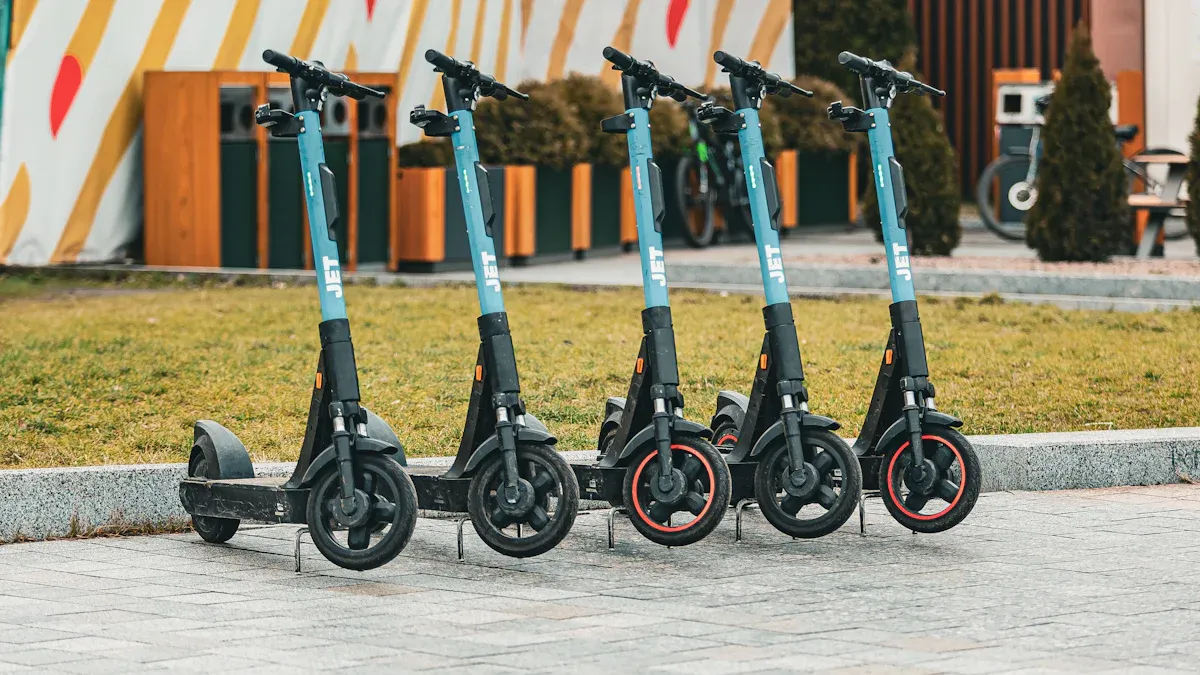
Semi-solid-state batteries redefine electric mobility by delivering superior performance for e-bikes and e-scooters. They offer enhanced safety features, including reduced flammability and improved thermal stability, making them a game-changer for e-bike and e-scooter. Large Power’s NCM semi-solid-state batteries can pass both the nail penetration and overcharge tests while achieving an energy density of at least 230 Wh/kg.
Key Takeaways
Semi-solid-state batteries are safer with less fire risk. They also stay stable in heat, making them better for e-bikes and e-scooters.
These batteries store more energy, up to at least 230 Wh/kg. This means you can ride longer without charging often.
They charge faster too. Advanced batteries go from 15% to 90% in 18 minutes, saving you time.
Part 1: What are Semi-Solid-State Batteries?
1.1 Definition and Overview
Semi-solid-state batteries represent a cutting-edge innovation in energy storage technology. Unlike traditional lithium-ion batteries, which rely entirely on liquid electrolytes, these batteries use a semi-solid electrolyte that combines the benefits of both liquid and solid-state systems. This unique design enhances energy density, safety and flexibility, making it ideal for electric mobility applications like e-bikes and e-scooters.
1.2 How They Differ from Lithium-Ion and Solid-State Batteries
Semi-solid-state batteries bridge the gap between lithium-ion and solid-state technologies. You gain enhanced safety due to their solid electrolyte structure, which minimizes risks like leakage or combustion. Unlike traditional lithium-ion batteries, which use flammable liquid electrolytes, semi-solid-state batteries offer greater thermal stability.
Energy density is another key differentiator. NCM Semi-solid-state batteries often exceed 200 Wh/kg, outperforming lithium-ion batteries limited by material constraints. They also provide longer cycle life, ensuring durability during repeated charging and discharging.
Here’s a comparison of key advantages:
Advantage | Semi-Solid-State Batteries | Conventional Batteries |
|---|---|---|
Safety | Improved | Moderate |
Energy Density | Higher | Lower |
Cycle Life | Longer | Shorter |
Operating Temperature Range | Wider | Narrower |
Semi-solid-state batteries also excel in fast charging, supporting rapid energy replenishment without overheating. While lithium-ion batteries remain more economical, semi-solid-state technology promises affordability as production scales up.
Part 2: Key Advantages of Semi-Solid-State Battery for E-Bike and E-Scooter

2.1 Improved Energy Density and Range
Semi-solid-state batteries deliver exceptional energy density while enhancing safety, revolutionizing electric scooter batteries and e-bike power systems. You benefit from extended battery range, enabling longer rides without frequent recharging. These batteries achieve energy densities of up to 230-270 Wh/kg, surpassing traditional lithium batteries like NCM (160–270 Wh/kg) and LCO (180–230 Wh/kg).
This leap in energy density ensures that your e-bike or e-scooter can travel farther, making semi-solid-state battery for e-bike and e-scooter a superior choice for urban and long-distance mobility.
2.2 Enhanced Safety Features
Many e-bike fires are caused by cheap, uncertified lithium batteries, which suffer from poor safety performance. These batteries often lack proper manufacturing quality and are prone to thermal runaway. The absence of standard regulations and widespread use of low-cost, unsafe packs—especially in budget e-bikes—has led to a significant fire risk. New York City’s battery fire crisis has drawn the attention of lawmakers, government officials, and corporations to battery safety.
Safety remains a critical factor in battery performance, and semi-solid-state batteries excel in this area. You gain peace of mind knowing these batteries minimize risks like fire, explosion, or leakage. Their semi-solid electrolyte structure offers greater thermal stability compared to lithium batteries, which rely on flammable liquid electrolytes.
Certification | Overview | Purpose | Applications |
|---|---|---|---|
IEC 62133 | Safety requirements for portable sealed secondary cells and batteries | Evaluates safety in portable devices | Widely adopted for rechargeable cells |
UL 1642 | Focused on safety of lithium cells | Evaluates risks of fire or explosion | Individual cells in consumer electronics |
UL 2054 | Targets household and commercial battery packs | Evaluates overall safety of battery packs | Common for consumer electronics and medical devices |
IEC 62619 | Requirements for safe operation of lithium cells in industrial applications | Tests for thermal propagation and internal short-circuit risks | Industrial applications like energy storage systems |
These certifications highlight the robust safety measures integrated into semi-solid-state battery technology. Additionally, Large Power’s semi-solid-state batteries pass both the nail penetration test and the overcharge test, further demonstrating their resilience under extreme conditions.


2.3 Faster Charging Times
Semi-solid-state batteries redefine charging efficiency, saving you valuable time. Factorial’s FEST battery cells showcase remarkable advancements, charging from 15% to over 90% in just 18 minutes at room temperature. This rapid charging capability outperforms conventional lithium batteries, which often require hours to recharge fully.
2.4 Durability and Longevity
Semi-solid-state batteries offer extended lifespan, reducing the need for frequent replacements. You benefit from longer cycle life due to reduced electrolyte degradation, ensuring reliable battery performance over time.
Longer cycle life compared to conventional lithium batteries.
Ability to maintain performance across a wide temperature range.
For example, LiFePO4 lithium batteries provide 2,000–5,000 cycles, while semi-solid-state batteries match or exceed this durability. However, NCM semi-solid-state batteries offers far more energy density. This durability ensures your e-bike or e-scooter remains operational for years, maximizing your investment.
Part 3: Semi-Solid-State Battery for E-Bike and E-Scooter vs. Other Electric Scooter Batteries

3.1 Semi-Solid-State vs. Lithium-Ion Batteries
When comparing semi-solid-state batteries to lithium-ion batteries, you notice significant advancements in performance, safety, and durability. Semi-solid-state batteries utilize a semi-solid electrolyte, which enhances energy density and thermal stability. In contrast, lithium-ion batteries rely on liquid electrolytes, which are prone to leakage and flammability.
Here’s how these two technologies differ:
Feature | Semi-Solid-State Batteries | Lithium-Ion Batteries |
|---|---|---|
Energy Density | Up to 375 Wh/kg | 160–270 Wh/kg (NCM) |
Cycle Life | Longer | 1,000–2,000 cycles |
Thermal Stability | Higher | Moderate |
Safety | Enhanced | Risk of fire/leakage |
Charging Speed | Faster | Slower |
Semi-solid-state batteries excel in energy density, reaching up to 375 Wh/kg. The NCM semi-solid-state batteries developed by Large Power can pass both the nail penetration test and the overcharge test, offering greater safety than conventional NCM batteries. This improvement translates to longer ranges for e-bikes and e-scooters, reducing the need for frequent recharging. Additionally, the semi-solid electrolyte minimizes the risk of thermal runaway, a common safety concern with lithium-ion batteries.
You also benefit from faster charging times with semi-solid-state batteries. For example, advanced FEST cells charge from 15% to 90% in just 18 minutes, while lithium-ion batteries often require hours to achieve a full charge. This efficiency makes semi-solid-state technology ideal for urban mobility solutions where quick turnaround times are essential.
However, lithium-ion batteries remain more cost-effective due to their established manufacturing processes. As semi-solid-state technology scales up, production costs are expected to decrease, making it a more accessible option for electric mobility applications.
Note: While lithium-ion batteries dominate industries like consumer electronics and medical devices, semi-solid-state batteries are rapidly gaining traction due to their superior performance metrics.
3.2 Semi-Solid-State vs. Sodium-Ion Batteries
Sodium-ion batteries offer an alternative to lithium-based technologies, but they fall short when compared to semi-solid-state batteries in key performance areas. Sodium-ion batteries use sodium ions as charge carriers, making them a more abundant and cost-effective option. However, their lower energy density and shorter cycle life limit their application in high-performance electric mobility solutions.
Feature | Semi-Solid-State Batteries | Sodium-Ion Batteries |
|---|---|---|
Energy Density | Up to 375 Wh/kg | 100–150 Wh/kg |
Cycle Life | Longer | Shorter |
Material Availability | Moderate | High |
Safety | Enhanced | Moderate |
Application Suitability | High-performance mobility | Low-power systems |
Semi-solid-state batteries outperform sodium-ion batteries in energy density, achieving up to 375 Wh/kg compared to the 100–150 Wh/kg range of sodium-ion batteries. This difference significantly impacts the range and performance of e-bikes and e-scooters. Sodium-ion batteries are better suited for low-power applications, such as stationary energy storage systems, where energy density is less critical.
You also gain superior safety features with semi-solid-state batteries. The semi-solid electrolyte provides greater thermal stability, reducing risks like overheating or combustion. Sodium-ion batteries, while safer than lithium-ion batteries, do not match the robust safety profile of semi-solid-state technology.
Another limitation of sodium-ion batteries is their shorter cycle life. Frequent replacements increase long-term costs, making them less economical for high-demand applications like electric mobility. Semi-solid-state batteries, with their extended lifespan and durability, offer a more reliable solution for e-bikes and e-scooters.
Tip: If you prioritize performance and longevity for your electric mobility needs, semi-solid-state batteries provide a clear advantage over sodium-ion alternatives.
Part 4: Challenges and Future Potential of Semi-Solid-State Battery for E-Bike and E-Scooter
4.1 Current Limitations
Semi-solid-state batteries represent a significant leap in battery technology, but they face certain challenges. One of the primary issues is production cost. Manufacturing these batteries requires advanced materials and processes, making them currently more expensive than conventional lithium-ion batteries. However, for companies committed to social responsibility, safety should never be compromised.
You may also encounter limitations in energy density improvements. While semi-solid-state batteries outperform traditional lithium batteries, they have yet to reach the theoretical energy density of fully solid-state batteries. This gap highlights the need for further research and development to unlock their full potential.
4.2 Future Developments
The future of semi-solid-state batteries looks promising. Researchers are working to reduce production costs by developing more efficient manufacturing techniques. Scaling up production will make these batteries more accessible for e-bikes and e-scooters.
Advancements in material science will likely enhance energy density and improve the long cycle life of these batteries. Innovations in semi-solid electrolytes could bridge the gap between semi-solid-state and fully solid-state batteries, offering even greater performance and safety.
You can also expect improvements in charging technology. Faster charging times will make semi-solid-state batteries even more convenient for urban mobility. As the industry invests in this battery technology, it will play a pivotal role in shaping the future of electric mobility.
Tip: Keep an eye on breakthroughs in solid-state batteries. These advancements will directly influence the evolution of semi-solid-state technology.
Semi-solid-state batteries redefine electric mobility with unmatched efficiency and reliability. You gain superior energy density, achieving up to 375 Wh/kg, and enhanced safety features like thermal stability. High discharge rates maintain 93.5% capacity, ensuring consistent performance. These advancements, coupled with rapid charging and durability, position semi-solid-state technology as a pivotal innovation for e-bike and e-scooter applications.
FAQ
1. What makes semi-solid-state batteries safer than lithium-ion batteries?
Semi-solid-state batteries use non-flammable electrolytes, reducing fire risks. Their thermal stability prevents overheating, ensuring safer operation for your e-bike or e-scooter. In addition, Large Power’s semi-solid-state batteries can pass both the nail penetration test and the overcharge test, offering greater safety than conventional NCM batteries.
2. How long does it take to charge a semi-solid-state battery?
Advanced semi-solid-state batteries, like FEST cells, charge from 15% to 90% in just 18 minutes, offering faster charging compared to traditional lithium-ion batteries.
3. Can semi-solid-state batteries withstand extreme conditions?
Yes, they operate effectively in temperatures ranging from -22°F to 113°F. Their robust design resists compression and vibration, making them ideal for rugged terrains.






